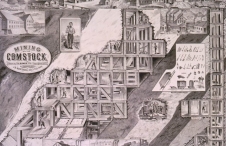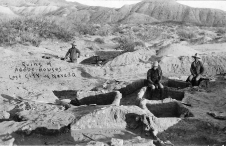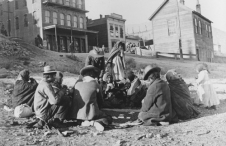Nevada's First Mining
Nevada is known as a mining state due to its history of silver and gold mining, which began in the nineteenth century. However, the first miners in Nevada were Native Americans, starting perhaps more than 2000 years ago. Metals that were important in times that are more recent were not important to prehistoric miners, as there was no knowledge of smelting. Important minerals for mining included salt, turquoise, magnesite, and other minerals.
Salt was especially important to the Anasazi (Ancestral Puebloans) because of a shift in their diet. As the culture developed, agriculture replaced hunting and gathering as the main source of obtaining food. Animal meat provides salt, which is necessary for human survival. Replacing part of the diet with plant material cuts the amount of salt, and it must be supplemented.
There were four salt mines located along the lower Virgin River along the border of Nevada and Arizona within fifty miles of the Lost City. These mines were archaeologically excavated in the 1920s by Mark Raymond Harrington. Cultural material in the mines varied in depth from 5 to 8.5 feet and prompted Harrington to propose that mining had been taking place there for more than 2000 years. Salt was probably an important trade item out of the Lost City. Prehistoric mining artifacts that were recovered from the salt mines include picks, hammers, fiber net bags, and torch fragments.
Turquoise is a copper mineral that is deposited by water solutions. It can occur as veins in cracks of rocks, as nuggets, or as massive deposits. Turquoise crystals are rare, but turquoise solution can form in the cast of another crystal and take on its shape.
There are no turquoise deposits in the immediate area of the Lost City. Important mines are located in northern Nevada, western Arizona and western Colorado. The nearest turquoise deposits are located near present-day Boulder City and just over the Nevada-California border southwest of Primm. None of the turquoise found in the Lost City sites has been sourced. Because of the great value placed on turquoise, it may have been traded from great distances.
Magnesite is a sedimentary rock that has been deposited by dissolved materials being transported by water and is formed by the replacement of magnesium for calcium in limestone. A large magnesite deposit is located about three miles south of Overton, near the center of the Lost City. The Anasazi used it as a white slip for pottery.
Other materials mined by the Anasazi include red and yellow ochre, which are iron oxides used as pigment and iron ore used to make paint for pottery. Rocks used for tools are usually quarried rather than mined and include chert, chalcedony, jasper, and obsidian. All of these materials, with the exception of tool-grade obsidian, are available within a few miles of the Lost City sites.




